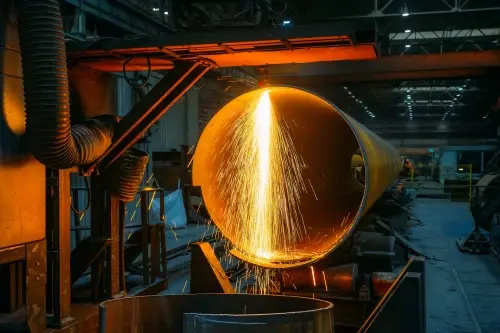When the heat treatment process is performed well, ultrasonic testing usually exhibits the following characteristics:

Clear bottom wave and low-noise background
Adequate heat treatment can promote grain refinement and homogenization of materials, significantly reducing ultrasonic scattering attenuation. This is manifested in strong and stable bottom wave reflection signals in the detection spectrum, minimal background noise (grass-like waves), and significantly improved signal-to-noise ratio. For example, in low-carbon steel, when the temperature is controlled within the ideal detection range of 0-60 ℃, the bottom wave gain value is stable and the attenuation degree is low.
Enhancing the credibility of defect display
If defects are detected in forgings after effective compaction and sufficient heat treatment, they can be judged as metallurgical defects (such as shrinkage cavities and inclusions); If there are no abnormalities detected after rough machining, but defect signals appear after performance heat treatment, the defect is likely to originate from the heat treatment process itself (such as quenching cracks) rather than the previous process. At this point, the defect wave features are obvious: strong independence, sharp waveform, and may be accompanied by wandering signals
Characterization of internal uniformity of materials
Heat treatment optimization can improve material density and reduce the propagation loss of ultrasonic waves in the matrix. For workpieces with smaller cross-sections, even four or more clear bottom waves can be observed, indirectly reflecting good internal uniformity of the material.
Elimination of stress-related pseudo-defects
The residual stress caused by improper heat treatment may lead to abnormal waveforms, similar to those of dense inclusions, especially in the bending parts of shaft components. Standardized heat treatment (such as timely tempering) can eliminate such stress concentration and avoid the formation of false defect signals in ultrasonic testing.
Clear determination of defect nature
Suppose delayed defects (such as white spots) appear after heat treatment. In that case, a comprehensive analysis should be conducted based on the original hydrogen content of the steel ingot and the heat treatment process. But a standardized heat treatment process can significantly reduce such risks, making it easier to classify defects that occur during testing as substantive metallurgical problems.
key factors
Temperature control: When the temperature of the workpiece exceeds 60 ℃ during detection, it will cause intensified sound wave scattering, significantly increase the bottom wave gain, and affect the accuracy of defect identification.
Organizational status: The grain size after heat treatment directly affects the attenuation coefficient, which in turn determines the bottom wave stability and noise level.











